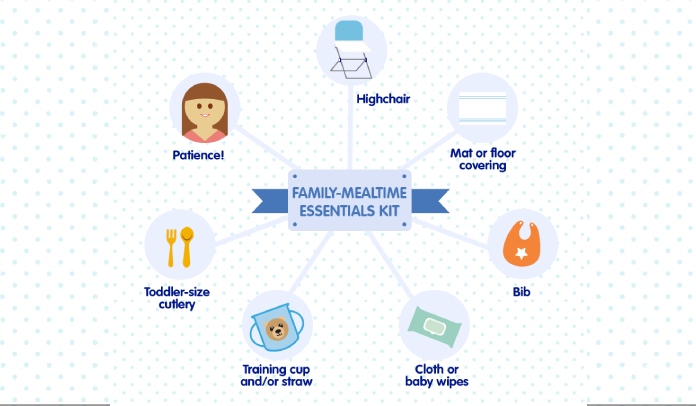























Your family-mealtime essentials kit

Preparation is key when it comes to pleasant mealtimes for the whole family. It’s as important to think about how you offer your toddler food as what you offer her. Provide a warm, nurturing environment, without any pressure on your toddler to eat. Having these items ready may help you feel more relaxed, giving you the chance to engage and interact with your toddler for a shared family meal.
- Highchair
Keep your toddler safe by strapping her into a highchair that is pulled up to the family table. Remember that she has a short attention span so may not be able to sit there for a long time. It’s a good idea to wait until her meal is ready (and cool enough to eat) before putting her in the highchair.
- Mat or floor covering
Your little one is still learning to feed herself so don’t be surprised if some food misses the target and ends up on the floor. She may also be more interested in playing with food than eating it. This is completely normal. If she starts throwing food or utensils, it may be a sign she’s finished. Remind her that throwing is not allowed. If it continues, take her out of her highchair and let her know that she can continue to play—just not with her food.
- Bib
Encourage your toddler to feed herself, even though she hasn’t completely mastered her cutlery skills quite yet. She may be able to get food onto a spoon, but it might not all make it into her mouth without spilling. Protect her clothes with a bib or covering and offer a combination of finger foods and foods that she can try to spoon-feed herself.
- Cloth or baby wipes
Toddlers discover new foods and textures with all their senses. Wanting to touch, smear, and squish foods instead of eating them is completely natural. Let her explore and get messy during the meal. Then be ready for the big clean-up once she’s finished.
- Training cup and/or straw
Offer milk or water in an appropriately sized cup with easy-to-hold handles. You can try a training cup with a spout (free-flow rather than with a valve) but aim for an open cup or even a cup with a straw. This will help your little one learn to sip rather than suck.
- Toddler-size cutlery
Little hands need little spoons, forks, and (non-sharp) knives. Cutlery with easy-grip handles can make it easier for her to control.
- Patience!
Your toddler is busy learning a lifetime skill and needs to practice in her own time. She’ll probably take longer to finish her meal than the rest of the family, so try not to rush her. Keep the atmosphere pleasant and take the opportunity to enjoy a conversation as a family. That way, she’s learning eating and social skills at the same time.

Don’t forget about how you are offering food to your toddler!
Even though your toddler is becoming more independent at the dinner table, your parent feeding style is still important for her future health. “Indulgent or uninvolved parenting has been associated with children’s higher body weight,” explains Lisa Fries, PhD, Behavioral Science Specialist at Nestlé Research in Switzerland. “A responsive feeding style is linked to healthier weight and dietary intake in children. For toddlers, this means offering a variety of foods in a warm, nurturing environment, and having structured mealtimes with consistent expectations (such as children eating at the table). As always, it is important to respond to your toddler’s hunger and fullness cues.” So, don’t forget to follow the principles of responsive feeding. See The dos and don’ts of responsive feeding and What’s your feeding style? for helpful reminders of good feeding practices for your little one.
Sources
- Black MM, Aboud FE. Responsive feeding is embedded in a theoretical framework of responsive parenting. J Nutr 2011; 141(3): 490-4.
- Bonuck K, Ben Avraham S, Hearst M, et al. Is overweight at 12 months associated with differences in eating behaviour or dietary intake among children selected for inappropriate bottle use? Matern Child Nutr 2014; 10(2):234-44.
- Dattilo AM Programming long-term health: Effect of parent feeding approaches on long-term diet and eating patterns. In: Early nutrition and long-term health, mechanisms, consequences and opportunities. Ed., Saavedra and Dattilo, Elsevier, 2017: 471-95.
- Gooze RA, Anderson SE, Whitaker RC. Prolonged bottle use and obesity at 5.5 years of age in US children. J Pediatr 2011; 159(3):431-6.
- Hurley KM, Cross MB, Hughes SO. A systematic review of responsive feeding and child obesity in high-income countries. J Nutr 2011; 141(3):495–501.
- Shloim N, Edelson LR, Martin N, et al. Parenting styles, feeding styles, feeding practices, and weight status in 4-12 year- old children: A systematic review of the literature. Front Psychol 2015; 6:1849. doi: 10.3389/fpsyg.2015.01849.
- Sleddens EF, Gerard SM, Thijs C, et al. General parenting, childhood overweight and obesity-inducing behaviors: a review. Int J Pediatr Obes 2011; 6(2-2): e12–27.
- Vollmer RL, Mobley AR. Parenting styles, feeding styles, and their influence on child obesogenic behaviors and body weight: a review. Appetite 2013; 71:232-41.
- World Health Organization. Guideline: Sugars intake for adults and children. Geneva: World Health Organization; 2015.
- https://www.aap.org/en-us/about-the-aap/aap-press-room/aap-press-room-media-center/Pages/Weaning-from-the- Bottle.aspx (Accessed August 8 2018)
- https://www.aap.org/en-us/about-the-aap/aap-press-room/Pages/American-Academy-of-Pediatrics-Recommends- No-Fruit-Juice-For-Children-Under-1-Year.aspx (Accessed August 8 2018)